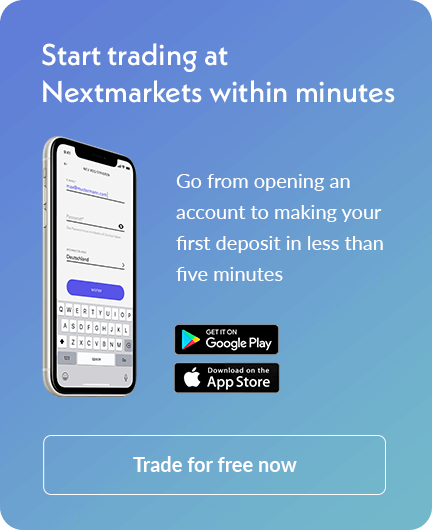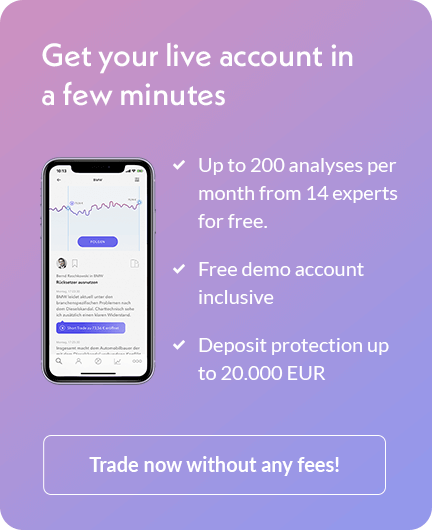How to buy cryptocurrency
Millions of people buy and sell cryptocurrency on a daily basis after learning of its vast potential as a digital asset. This guide will teach you how to buy cryptocurrency and explain how traders profit from price fluctuations.
This guide is aimed at anyone that wants to learn how to invest in cryptocurrency, how to trade cryptocurrency and where to buy cryptocurrency. It lays out the basics of crypto, details your various options for investing in the space, lists the key cryptocurrencies in circulation, and highlights the analytical methods used by those seeking to profit from it.
❗ Disclaimer: Currently, at nextmarkets you can only trade CFDs on Bitcoin, Ethereum, Litecoin and Bitcoin Cash!

The basics of cryptocurrency
Cryptocurrencies emerged after the 2008 financial crisis. The pseudonymous Satoshi Nakamoto published a famous white paper that year, explaining the vision for Bitcoin and the problems it could solve. Bitcoin was released to very little fanfare in 2009, but nowadays it regularly dominates the financial news agenda. The value of Bitcoin has soared over the past decade, earning a blaze of publicity in the process.
Bitcoin (BTC) is a decentralized coin that allows peer-to-peer transactions to take place online. It operates on a blockchain, which is a public electronic ledger used for recording transactions. Bitcoin is mined by separate nodes within the community, in a process known as proof of work. Miners verify transactions, maintain the integrity of the blockchain and receive a reward in the form of BTC for their efforts. There is a limited supply of BTC, and its relative scarcity has made it an attractive asset class for investors.
Bitcoin accounts for roughly 60% of the total cryptocurrency market value, but it has spawned thousands of alternative cryptocurrencies, known as altcoins. The most prominent of the bunch is Ether, the native token on the Ethereum blockchain, but there are dozens of high-profile coins in circulation, from Litecoin to Polkadot.
Most of them are decentralized, meaning that no central authority issues them or governs the flow of money. They operate on a community, peer-to-peer basis, and allow users to circumvent traditional financial institutions. This has the potential to make online transactions quicker, cheaper and more secure. Regulators are now taking a keen interest in crypto, but these coins operate on an international basis and it is relatively difficult for a single government to clamp down on them. If anything, crypto simply continues to increase in popularity and grow more embedded into the economy, so we could see many more people wondering how to buy cryptocurrency in future.
There are three traditional ways to get hold of crypto – mine it, have someone send you it, or buy it. We will elaborate on all three methods and explain the pitfalls of each, before highlighting an exciting fourth option: trading cryptocurrency CFDs.
How to buy cryptocurrency
Mining is the process of solving complex cryptographic equations in order to verify a block on the blockchain. In the early days of Bitcoin, miners could solve these equations using basic computers, and the rewards would be vast. BTC was not worth much back then, but if they held onto their coins, they would be multimillionaires by now. However, it became increasingly competitive as the price soared, and it is now dominated by large companies that own vast mining factories in energy-efficient companies, or major mining pools. You can rent hash power from a cloud mining operation, but there are no guarantees that the crypto you receive will be worth more than the fees you pay.
It might therefore be easier to explore alternatives. You can get someone to send you crypto by setting up a wallet and providing them with your address, but you have to perform a service for them. If your crypto then decreases in value, you would end up wishing you had been paid in a fiat currency instead. You can buy Bitcoin, buy Ethereum or buy another altcoin from an exchange, but this comes with various issues.
Crypto fees
First, you have to pay a fee to buy the crypto. Then you have to think about where to store it. Many exchanges have been hacked over the years, as have web-based wallets and software wallets. You can buy a hardware wallet for offline storage, but that is not foolproof, and it can cause problems if you lose or damage it. There are all sorts of horror stories online about people losing millions of dollars’ worth of crypto by misplacing a hard drive.
You also have to pay network fees to send crypto to your wallet, and then pay more fees to send it back to an exchange when you decide to sell. There is the additional danger of accidentally sending your crypto to the wrong wallet, at which point it is lost forever. If you find the concept of buying, storing and selling crypto to be insecure and a hassle, you can look into CFDs.
Invest in cryptocurrency
A CFD is a contract for difference. The key advantage of a CFD is that it offers you exposure to an asset without requiring you to actually own it. CFDs are therefore popular on commodities such as oil, and they are also very popular on stocks, funds and forex currency pairs. They are perfect for the crypto sector, because they cut out the risks involved in buying, sending and storing crypto.
It is an agreement between you and your CFD broker, whereby one party agrees to pay the other party the difference between the price of the cryptocurrency when the trade is opened and the price of that cryptocurrency when the trade is closed. The overall profit or loss is determined by the size of that difference, and the number of contracts you buy.
A CFD is a financial derivative. It might initially sound a little complex, but it is actually very simple to buy and sell crypto CFDs. First, you need to get yourself an account with nextmarkets. The registration process takes just a few minutes. You will need to provide your personal details, verify your email address and phone number and complete a standard KYC process, then fund your account, and you can then start to buy and sell crypto CFDs.
The market section of the site has a cryptocurrency tab. Visit that and click on a particular coin, such as Bitcoin, Ethereum or Bitcoin Cash. You will then see charts that illustrate the coin’s recent performance. When you have decided if you think that a coin will increase or decrease in value, you can make your trading decision: “Go Short” or “Go Long”.
You would go short if you think the cryptocurrency will decrease in price. Go long if you think it will increase. As this is a how to buy cryptocurrency guide, you may be more inclined to go long, but cryptocurrency does not go up in a straight line, and many traders have profited from shorting it over the years, so it is important to consider all of your options.
You can then select the size of your position by deciding the quantity of contracts you wish to take out. This will determine your overall profit or loss, as the difference at the end of the contract is multiplied by the number of contracts you buy or sell. You can trade CFDs using leverage, which means you pay an upfront deposit and the rest of the trading position is loaned to you by the broker. It allows you to trade beyond the balance in your account, and it can significantly ramp up your profits, but it can also cause you to lose more than the value of the deposit, so you should never trade beyond your means and always conduct thorough research before opening a trade.
On that note, you can add in a stop-loss order when opening a trade. This instructs your broker to close the trade if the market moves against you to a specific price. It is an insurance policy, which prevents you from incurring any losses beyond a certain point, and it is free to use. On the other end of the spectrum, you can impose a take profit order, which instructs us to close the trade as soon as you hit a specific profit target, thus preventing your profit from being eroded in the event of the market moving in the opposite direction.
You can monitor open trades and close them when you decide to. Any profits will be added to your account balance, and you can withdraw funds whenever you like.
Advantages of crypto trading
- You can go long or short. This gives you a great deal of flexibility, as you can speculate on the price increasing or decreasing. That is not possible when you buy cryptocurrency in the more traditional way.
- Going short also allows you to hedge. For example, if you hold a considerable amount of a cryptocurrency in a wallet, but you fear the market will suffer a downturn, you can protect yourself by going short with a CFD.
- CFDs give you the opportunity to profit from a cryptocurrency without having to endure the rigmarole and security concerns of buying, sending and holding it. If you think Bitcoin or Ethereum will increase in value, but you do not want to pay purchasing fees and transfer fees and worry about your wallet being hacked, you can take out a crypto CFD instead. It is clean, simple and convenient, and you will not be charged any commission at nextmarkets.
- Crypto CFDs are regulated, so you will enjoy the sort of protection that is unavailable to people that buy crypto from unregulated exchanges.
The main cryptocurrencies
These are the key cryptocurrencies to familiarize yourself with:
Bitcoin (BTC) | The original cryptocurrency remains larger than every single altcoin combined. Its share of the overall crypto market cap stands at roughly 60%, and it has a huge influence on the value of altcoins. Bitcoin can be used to pay for a huge range of goods and services online, but many people like to HODL (hold on for dear life) it, as they expect it to significantly appreciate in value over the long-term. It has a limited supply of 21 million coins, and it has been dubbed “digital gold”.
Ethereum (ETH) | ETH is the native token of the Ethereum blockchain, and it is the world’s second largest cryptocurrency. The Ethereum blockchain is used for decentralized finance applications and many other projects, and ETH can be used to pay the gas fees, while it has plenty of real world uses at ecommerce sites too.
Bitcoin Cash (BCH) | This coin was created in a hard fork from Bitcoin in 2017 following a dispute among the community over how to speed up transaction times and solve scalability issues. It shares many of the same features as Bitcoin, but it has a larger block size and offers quicker transactions. BCH has passionate advocates and fierce detractors.
Binance Coin (BNB) | The native coin on the Binance ecosystem. It has grown in popularity as the Binance Smart Chain seeks to rival Ethereum in hosting decentralized finance projects.
Cardano (ADA) | Cardano is another blockchain that hosts decentralized finance projects. It was created by an Ethereum co-founder, and ADA is the native token.
Polkadot (DOT) | Gavin Wood, another Ethereum co-founder, created Polkadot. It is sometimes referred to as an Ethereum killer, but it actually differs slightly by providing a multi-chain interchange, which enables customized side chains to connect with public blockchains.
Litecoin (LTC) | This is known as the silver to Bitcoin’s gold, as it has a larger supply cap, and is designed to facilitate quicker, smaller transactions.
There are thousands of cryptocurrencies in circulation, all with their own quirks and special features, but those listed above have spent a considerable amount of time in the top 10 cryptocurrencies by market cap. Bitcoin and Ethereum are the most popular cryptocurrencies among traders.
Predict the future price
Technical analysis and fundamental analysis are used in a bid to predict whether a cryptocurrency will increase or decrease in value. Technical analysts hunt for historical price patterns by studying charts, and then apply these patterns to the current situation in order to predict future price moves. They concentrate on supply and demand in an effort to gauge the future direction of a coin.
Anyone wondering how to buy cryptocurrency should look into fundamental analysis, as it requires you to learn as much as possible about the value, role and unique selling point of each coin. You can also look into news announcements, regulatory issues, technological developments and wider economic trends, as that can help you predict whether a cryptocurrency is likely to appreciate or depreciate in value.
Conclusion
Crypto trading has exploded in popularity over the past decade and it is likely to grow increasingly commonplace in future. You can buy cryptocurrency CFDs in order to gain exposure to the sector without having to actually own the underlying asset, which is an appealing prospect for many investors. Make sure you use a regulated, reputable crypto broker site with a high-quality trading platform in order to make the process as simple, convenient and secure as possible.
How to buy cryptocurrency FAQs
- What is price action?
- Forex vs Stocks - Which is more profitable?
- Trading the news in forex
- What is forex lot size?
- How to trade forex? 2023 Guide for Beginners
- What is forex market?
- Currency trading for beginners
- What is cryptocurrency
- What are ETFs
- Stock market analysis - How to research stocks 2023
- How to short stocks
- How to buy stocks




